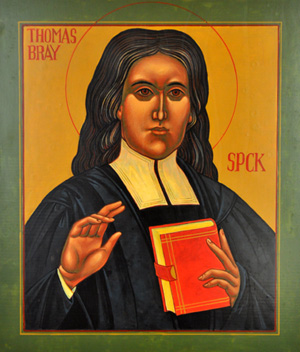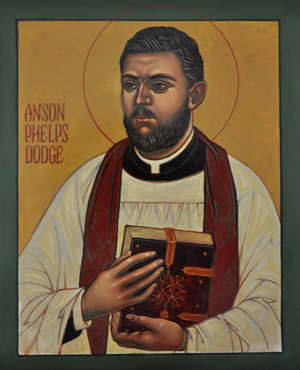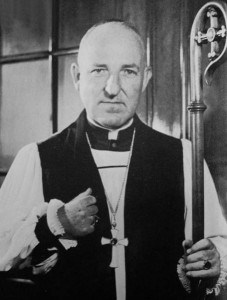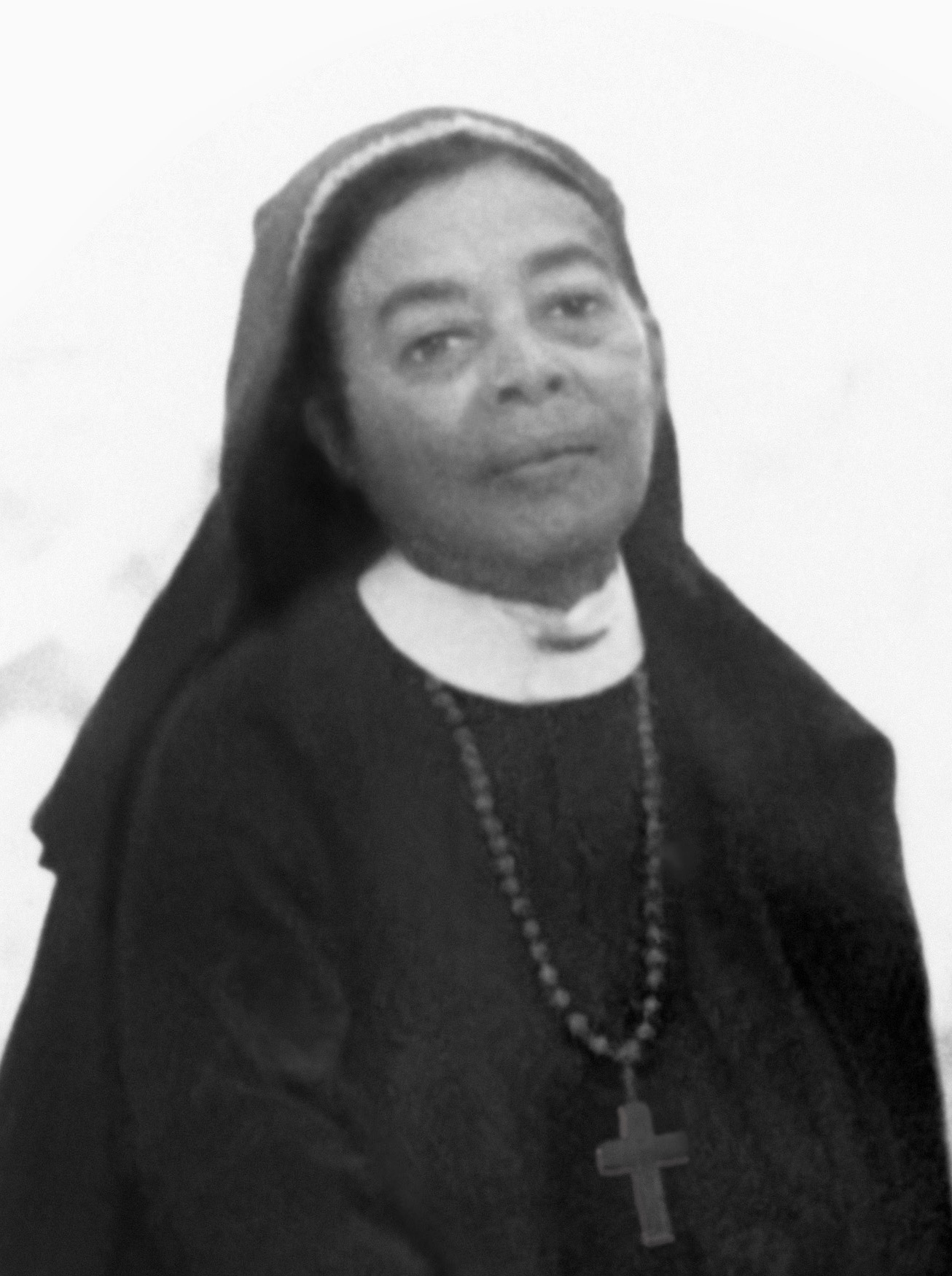Originally compiled by the Right Reverend Henry I. Louttit, 9th Bishop of Georgia
First edition, June 1998, Revised: June 1999, January 2004
Deaconess Byllesby added by Bishop Scott Anson Benhase April 2012
Note: Two calendar days in Lesser Feasts and Fasts are of particular importance in the history of the Diocese of Georgia. They are the Feast of John and Charles Wesley, and the Feast of Thomas Bray. Both of those tend to fall in Lent, not a good time for a major celebration in the parish.
I would like to suggest that the following days might be celebrated on a regular basis in your parish at a mid-week service, if you already have one scheduled. You may, therefore, observe the feast on the given day if you wish, or you may move it to any day in the week in which the feast falls when you already have the people gathered.
- Sir Thomas Bray – April 14th transferred
- Deaconess Ruth Byllesby – April 25th
- John and Charles Wesley- May 13th transferred
- Anson Dodge – June 18th
- Albert Rhett Stuart – July 8th
- Brother Jimmy Lawrence – September 3rd
- Deaconess Alexander – September 24th
- Bartholomew Zouberbuhler – October 22
- Bland Tucker – November 19th
If I were trying to encourage people to have some sense of the Communion of Saints, I would suggest using these dates plus a selection chosen from those in the Prayer Book calendar, so that perhaps twice a month you had a Eucharist focused around a special person, followed by a meal. For instance, you might observe April 25th, the Feast of St. Mark, not only as St. Mark’s Day but remembering all the evangelists.
Celebrate the Feast of the Ascension, May 21st (or its eve). Celebrate the Nativity of St. John the Baptist on June 24th, on which you could observe not only John but also all the Old Testament forbearers of the faith. In July, it seems right to do a major celebration in thanksgiving for our country in relationship to July 4th. In August, it’s the Feast of St. Mary. September, you could choose either Holy Cross Day or the Feast of St. Michael and All Angels. In October, the Feast of St. Francis seems widely observed. November, of course, you have the Feast of All Saints, which the Prayer Book expects to be observed on its day as well as on the following Sunday. Naturally, one would want to adapt this list to the interest in the local community, certainly including the feast of the title or patron saint.
Few parishes are going to be able to use all the entries in the Prayer Book calendar and the propers for Lesser Feasts and Fasts. On the other hand, for people almost to have no sense of the glorious company of saints from all ages and peoples, and with a great diversity of gifts, is to impoverish them. I believe most communities could work towards at least one celebration a month on a festal day. This would normally mean a meal, but it can be a very simple meal of soup and sandwiches. This is also an opportunity if you have younger people in the congregation to involve them in doing or taking part in liturgy in a way that is particularly age appropriate.
SIR THOMAS BRAY
(Propers: Lesser Feasts and Fasts)
Book of Common Prayer, February 15th (Lent is not a good time for parish observance)
Diocese of Georgia Calendar, April 22, or closest weekday service
Sir Thomas Bray is in our Prayer Book calendar because he was the most imaginative developer of support in England for the struggling congregations of Anglicans in the British Colonies.
For most of his life, he was rector of St. Botolph-Without-the-Walls, in London. The Bishop of London, who was responsible for the colonies, sent him to Maryland as his commissary (ambassador or representative). In his two-and-a-half month tour, Thomas Bray encouraged priests and lay folk alike, but he saw the terrible shortage of pastors and books—Bibles and Prayer Books. On his return to England, he founded the SPG, the Society for the Proclamation of the Gospel, to provide priests with stipends for churches in the colonies. The SPG provided clergy for Christ Church, Savannah, and St. Paul’s, Augusta. The society also provided a great Jewish convert, Joseph Ottolenghe, as a catechist to work with African slaves. He then founded the Society for the Propagation of Christian Knowledge (SPCK), to provide books. The SPCK is still the largest producer of theological books in the English language, though they are not sold in the United States. Today, there is a branch of the SPCK in the U.S. that works to provide Christian books in Lakota and Spanish, and provides books for seminary libraries throughout the world.
Thomas Bray was one of those great parish priests, who was faithful, not only in the ministry of his parish where he was very creative in social ministries and in preaching the Gospel, but also to God’s ministry to the whole world.
Among concerns of Thomas Bray was work to relieve people in prison, particularly debtors, who had ended up in jail. He developed a group of friends who ministered with beef and beer meals in the prisons on Sundays. A young James Oglethorpe joined him in this work. Sir Thomas Bray suggested the idea of a colony where people could have a new chance at life. This was the germ of the idea of General Oglethorpe’s Georgia. It is important to note that, though Thomas Bray died before Georgia was founded, the charter reflects his Christian utopian vision held by tolerant Anglicans of the 18th century. The Puritans were not the only committed Christians involved in founding colonies to better anticipate and work for the coming kingdom of Christ. Georgia was founded as a place where there would be no slaves, lawyers, and no accumulation of land (wealth) beyond 150 acres per family. The charter, as originally designed, also tolerated Christians of all churches and in the first year of the life of the colony they were wise to include tolerance of our forebears of the faith, as Jewish settlers arrived founding the second synagogue in the colonies. Christian idealism in the original charter was lost when Georgia became a royal colony.
Sir Thomas Bray, a parish priest who only left his parish for a two-and-a-half month tour of Maryland, provided a support system that was used by God, not only to plant the Episcopal Church in the United States of America but to build our communion as the second most widespread family of Christians in the world.
Give thanks for those supporting the founding of churches in our state. Pray that our Lord will be served by us, both in imaginative work for those in trouble in our communities and in our support for ministry in his name in other parts of the world.
DEACONESS RUTH BYLLESBY
April 25th
Collect: Almighty God, who chose your servant Ruth Ellis Byllesby to serve the poor, feed the hungry, and clothe your children: give us the grace to pattern our lives after the shining example of Blessed Ruth, that we may spread the Gospel by helping those in need, with humility and the heart of a servant, through Jesus Christ our Lord, who lives and reigns with you and the Holy Spirit, one God, for ever and ever. Amen.
Epistle: Phillippians 2:1-7 (8-10)
Psalm: 112
Gospel: Matthew 25:31-46
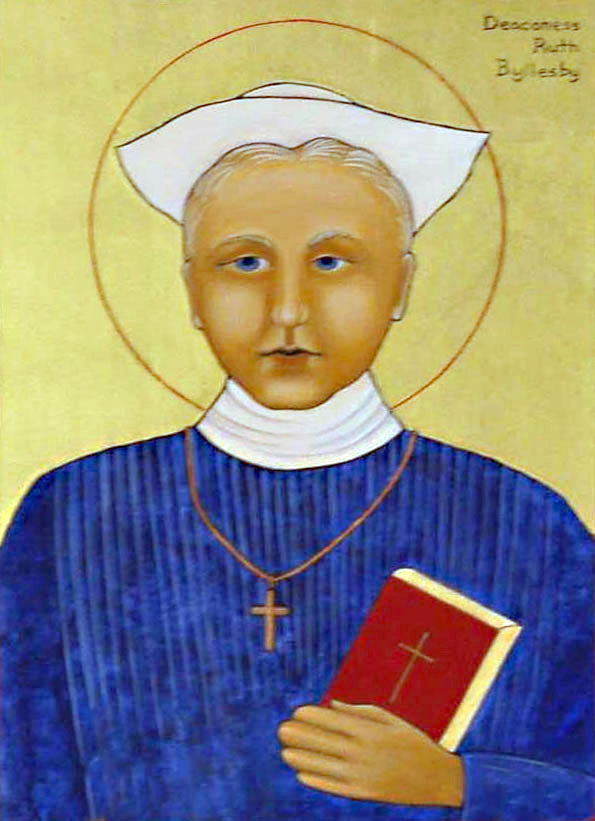
Ruth Ellis Byllesby was born 9 March 1865 in Meadville, PA where her father, Marison Byllesby, was the rector of Christ Episcopal Church. She graduated from Meadville high school and then studied at Brooke Hall in Media, PA. From 1894-96 she studied at the Philadelphia Deaconess Training School She was set apart November 17, 1896 at Trinity Church in Pittsburgh by Bishop Whitehead, and began a ministry serving working class women and children in Pittsburgh. In 1904 she moved to Morristown, New Jersey, where she served as a parish deaconess for several years. From 1913-1922 she served as a parish deaconess in Detroit.
Deaconess Byllesby served as a parish deaconess for Christ Church, Augusta from 1927 to 1943 when she retired. Two members of her family had provided an endowment for settlement House work, and that is what she created in Georgia, turning the Christ Church rectory into Neighborhood House to serve the mill families of the Harrisburg area. She provided basic needs for families and children throughout the depression, ran a Sunday School serving more than 200 children, started a young mother’s club and advocated for education for girls. For this work, the Diocese of Georgia has declared her a diocesan saint.
But the Deaconess service continue in retirement as in 1944 she spent the winter at St. Clare’s House in New York, then served at Ascension Parish in Pittsburgh from 1948-50. In 1950 Byllesby moved to Connecticut where her sister lived, but the next year she moved to Jacksonville, Florida. She died April 25, 1959 in St. John’s Florida.
The Reverend Harry Maloney, Rector of Christ Church in 1978, wrote the following: “I am amazed how she changed people and became a lasting influence in their lives. I am told she shared all she had of material wealth whatever that amounted to, with the people she ministered to but also she gave of herself so willingly and with so much love. It was this great love and compassion for people that caused her to be remembered.”
Her legacy of helping the poor, hungry and the lost is a shining example to all who came after her, bringing the consolation of the Gospel and the work of the Holy Spirit to Harrisburg and Augusta.
A well-documented article by Joan R. Gunderson in the journal Anglican and Episcopal History gives the fullest available picture of her life: In Plain Sight, and Yet Invisible: The Ministry of Deaconess Ruth Byllesby.
John and Charles Wesley
(Propers: Lesser Feasts and Fasts)
BCP Calendar, March 3rd (Lent is not a good time for parish observance)
Diocese of Georgia Calendar, week of May 13th
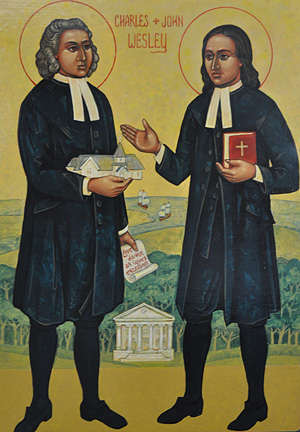
John’s father was a priest in Epworth, Lincolnshire, England. At Oxford, John, as an undergraduate, became convinced the Book of Common Prayer contained the discipline necessary to nurture a Christian into holiness. He gathered other students around him and they followed directions of the Prayer Book about daily Morning and Evening Prayer, fasting on Fridays, and making their communion weekly. John’s group was derisively called “Methodist” because they were so methodical following the rules or method of the Book of Common Prayer. John read theology at university and was ordained in the Church of England.
Seeking a position from which he could preach to non-Christians, he obtained appointment by the Society For the Proclamation of the Gospel to be a priest in the Colony of Georgia. He intended to be a missionary to Native Americans, but when he arrived in Savannah there was no priest or English-speaking pastor in the colony. Thus, the people of Savannah (and the SPG?) saw him as the rector of Christ Church. In Savannah, he preached in German to the Salzburgers, befriended the Jewish community, regularly led worship in German, Italian, and French for various groups of settlers, and worked hard to build up the parish church. At Christ Church on Sunday, he expected everybody to be present three times, following the design of the Book of Common Prayer. He scheduled Morning Prayer at 5 a.m., Ante-Communion (or, when the people would agree, Communion) and the Litany at 11 a.m., and Evening Prayer and the Catechism at 3 p.m.
John’s energy and dedication cannot be questioned. During his short ministry at Christ Church, the first Sunday School of any denomination was formed so that children and adults could learn to read and know the stories of the Bible. For the parish of Christ Church, John produced the first hymnal used in the Church of England (in Anglicanism). However, John, at this stage of his life, was not gifted with “people skills” and he made some serious pastoral mistakes. In the Royal Court in Charleston, the vestry brought charges against John for having people sing hymns of man’s composition—in the 18th century, most Anglicans only sang metrical psalms. Rather than face charges in court, John fled back to England.
Charles Wesley followed his brother to Oxford and also read theology. After being ordained, he obtained a position as General Oglethorpe’s clerk (secretary). He thus was a “bi-vocational” or non-stipendiary priest in the 18th century. Accompanying General Oglethorpe to Frederica on St. Simons Island, he served in his free time as chaplain to the military community, and out of his work there, grew Christ Church, Frederica. After he returned to England, his brother John, the only priest in the colony, would come down on horseback to hold services in Frederica, visiting other outlying settlements in the colony on his way.
The next part of the story is much better known. On the return voyage to England, John found support and prayer with a group of Moravian Christians. In London, as a young priest who had messed up his first position, had never had a chance to preach to the Indians, and who was a fugitive from a warrant in the Royal Court, John continued to keep the Prayer Book discipline. However, he was very discouraged. On Wednesdays, he attended a Moravian Bible study and prayer session, and it was in one of these that “his heart was strangely warmed.” At that moment he knew he was forgiven and that God could use him. Through friends, John became interested in an attempt by some church members to reach new dwellers in the rapidly growing towns caused by the Industrial Revolution. A traditionalist and conservative, it was very hard for John to change. His struggle about preaching outside of a church building and outside of the regular schedule and worship of the church is recorded in his diaries. John and Charles Wesley are important to Christian history for a number of different reasons, including being two of the great sources and creators of English hymnody. But twice in the history of the Church, the Church has lost a whole segment of the population because the culture changed. And both times, God raised up people who realized the Gospel — God’s love working for human beings—had not changed but the environment had. In such a way St. Francis and his brothers (friars) reclaimed the new town dwellers uprooted from the rural farms by the growth of crafts and commerce in the 12th century. In the 18th century, the Industrial Revolution meant that towns, which for almost a millennium had contained no more than fifty people, suddenly had a thousand people. Of course, churches were built to hold fifty and had been around for a long time—six or seven hundred years in many places. The service time had been set before anyone could remember, but now the industrialized mills were running at that time, so the new folk in town could not come. This was the world into which John and Charles were called to preach. They gave their lives to preaching the Gospel to the unchurched population produced by the Industrial Revolution. Some secular historians credit the Methodist movement with giving hope to the urban poor, thereby preventing a parallel in England to the bloody French Revolution. John organized his converts into classes (similar to Cursillo Reunion Groups), where people prayed, studied scripture, and took care of one another. He urged and directed them to go to their local (Church of England) parish church to make their communions. But the local Church of England parishes seldom arranged for the services at a time when they could come, and almost never allowed John, Charles, their friends or followers to preach within their walls. Socially, this was the beginning of a new middle class, an opportunity and encouragement for a person to work one’s way out of poverty. The Wesley—members of the Church of England—preached the Gospel outside the church walls, when the church structure could not see the harvest God had provided.
To preach to the tens of thousands of unchurched, John called on his fellow pastors of the Church of England. But few wanted to give up the security and comfort of the gracious religion of the landed gentry. At the same time, John remembered being the only English-speaking pastor in the whole colony of Georgia (there was a German-speaking pastor among the Salzburgers). He knew that the situation was similar in many of the British colonies. Both Oxford and Cambridge were founded to train priests. However, by the 18th century, Oxford and Cambridge graduates did not want to go and camp out in the greenbrier jungles in Georgia when good church jobs could be had. Few volunteered. People converted by the Wesleyan revival volunteered, but they were not “seminary” graduates! John tried all of his life to get the church to ordain people willing to serve, but our church could not hear him. Despite the stodginess of the church, which could not see the harvest God had placed on its doorstep, John remained loyal. On his deathbed, he said, “Do not leave the church. We are here to revive it, not divide it.” However, in desperation, as no bishop would ordain ministers for the colonies, John as a presbyter (following a Roman Catholic doctrine of the time) ordained converts and sent them. These folks were called “circuit riders.” One of the great missionary stories of all time, they converted the American frontier. But don’t be too hard on the Oxford graduates, the average age of death of a circuit rider was 32—it was a “killer job.”
We give thanks to the devotion of the circuit riders in the colonies, and the itinerant preachers of the Gospel throughout the British Isles, who converted through their love of the Gospel a new people for Christ and a new culture that was on the Church’s doorstep. And we give thanks to God for giving us leaders with the vision of John and Charles Wesley, who see what God is doing in his world, and *ray that God will give us the vision to see the mission he has set before us, and the strength to minister in new ways under his direction.
The Rev. Anson G.P. Dodge, Jr.
(Propers: For a Missionary II, LFF)
Diocese of Georgia Calendar, week of June 17th
The outline of Anson Dodge’s life is well portrayed in Eugenia Price’s historical novel, The Beloved Invader.
The young son of a wealthy New York City family, he was sent south after the civil war to see the condition of the family’s timber property on St. Simons Island. He was so horrified by the Union Army’s treatment of the building of Christ Church, St. Simons, that on his return to New York he entered General Theological Seminary from whence he returned to spend his life pastoring and rebuilding Christ Church, Frederica, as a religious community, in addition to rebuilding its building.
What is not so clear from the novel is his energy in riding out from St. Simons preaching to all he could gather, regardless of race, and forming them into congregations. His foundations clearly stand out in the old list of the Diocese of Georgia, because he was deeply affected by the Latin and Greek fathers of the early Church, (the first 4 centuries).
Thus, he dedicated his new congregations to St. Ignatius, St. Cyprian, St. Ambrose, St. Perpetua, St. Athanasius, as well as to the Messiah, Transfiguration, and St. Andrew, names still common today. He founded six chapels along the Satilla River. He worked as far inland as Waycross, founding the Church of St. Ambrose there.
His family fortune allowed him to financially underwrite a priest to serve some of these congregations and assist him in his work. He also restored life at what is now Christ Church, St. Marys, St. Andrew’s, Darien, (which had been burnt to the ground), and St. Mark’s, Brunswick.
Lovely Lane Chapel, now at Epworth, the Methodist Conference Center, is the church he built for the mill workers in St. Simon’s Village. His concern for the church led him to build a dorm still in use at General Theological Seminary in New York City, and a cathedral in India, which was destroyed in the India-Pakistan war.
Mr. Dodge was always a pastor. His concern for people in trouble was a great witness to God’s compassion. His last work was to found an orphanage in his home for boys. That work goes on as an endowment helping young men through the Episcopal Youth and Children’s Service of our diocese.
Pray for leaders in our congregations, lay and ordained, whose vision of God’s call to ministry reaches beyond the local scene and who have compassion to reach out in Jesus’ name to any person who is hurt or lost.
Albert Rhett Stuart
(Propers: For the Unity of the Church, Book of Occasional Services)
Diocese of Georgia Calendar, week of July 8th
After a distinguished ministry as a priest, as rector of the Church of the Resurrection Greenwood, South Carolina, as rector of St. Michael’s, Charleston, then as dean of Christ Church Cathedral in New Orleans, Father Albert Rhett Stuart was elected the sixth bishop of Georgia. He came to Georgia concerned about building a church gathered around God’s altar that lived its sacramental heritage from the Book of Common Prayer. He, for many, was an icon of Christ’s presence. He attracted young priests as he moved towards having a priest for every congregation. However, another issue arose before the whole church out of the Gospel, which involved the inclusion of all people in God’s church. In the early years of the twentieth century, Georgia, by law, had strictly separated black and white folk. Despite protests, the church had followed suit. For the first 110 years of the Church here in Georgia, most congregations had communicants of both races. In 1947, under the leadership of Dr. Bland Tucker of Christ Church, Savannah, African-American congregations had once again been given representation in the diocesan convention, their presence there having been suspended in 1907. Housing and meals were complicated for the convention in a legally segregated state, but now the issue of reintegration of congregations went before the church and society. I remember a very large man in cope and miter leaning against the outside of the pulpit of the small church that seated 40 people in Statesboro, Georgia, and saying, “This is a free country. You can belong to any kind of church you wish, but the Episcopal Church has never asked anyone why they were coming to the church. We are not starting asking people now. This church is open to anyone who wishes to worship.” That was before the Federal Civil Rights Act was passed. Not all of our members agreed, but Bishop Stuart stood on the Gospel. He was a leader in helping society face integration. He was often seen on the TV’s news as the only white leader publicly speaking for integration in Savannah as public facilities were integrated. For this, he took much abuse and some threats. A man of great personal conviction, he was seen by many priests and lay people of Georgia as a “Moses,” leading us to a deeper relationship with God known in Jesus Christ. He caused many people to have an understanding that the Episcopal Church was given special gifts by God to share in Christ’s name, giving us confidence that, though we were a small part of the population, we mattered in God’s ministry. He was committed to adult Christian education and built the Honey Creek Conference Center, which is a lasting memorial to his vision of an adult church at work ministering in Christ’s name. Of course, it was also a wonderful facility for our young people and children.
One personal story from our current bishop: I had begun my ministry at Trinity Church, Statesboro. After a couple of years, St. Mary’s Church in Middlesboro, Kentucky, called me as their rector. They wined and dined Jan and me and showed us all the opportunities for ministry in the area. Upon returning to Statesboro, the phone rang, I answered, and a voice said, “Henry, this is the Holy Spirit, the answer is, ‘No’,” and the phone line went dead. I knew the voice was that of the bishop, but never doubted that they were the words of the Holy Spirit. I said, “No thank you,” to the lovely people of Kentucky and continued to be blessed by God through his people in Georgia. I have often wished for such clear direction in other difficult decisions.
Bishop Stuart is still a model for me of God’s patient love reaching out to others at the same time as he patiently works for justice in society.
Pray that we may stand with integrity for justice in our world but always with compassion for sinners, including perpetrators of injustice.
Brother Jimmy Lawrence
(Propers: For a Pastor I, LFF)
Diocese of Georgia Calendar, week of September 3rd
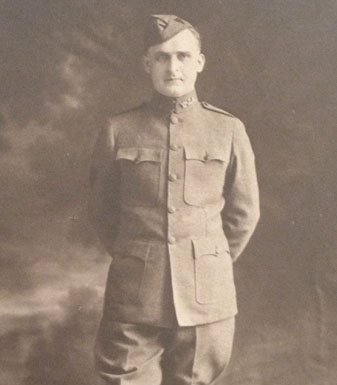
Doctor Lawrence came to be rector of Calvary, Americus, in 1904. He was a bachelor who had many connections in New York City. He immediately set about sharing the Gospel anywhere people would listen. He would get on the train, and go to the next stop, get off and gather people to hear the Gospel. He was a friend and image of God’s love to many who were or became active in other churches. But besides seeing significant growth in the membership at Calvary in Americus, he founded churches in Pennington (the log chapel is now in a historical reconstruction of a village at the gates to Andersonville), in Vienna (Prince of Peace Episcopal Church’s building is now a civic concert hall and auditorium standing next to the school), in Cordele (Christ Church), and in Blakely (Holy Trinity where oaks he planted have grown to an impressive size and now shade the lawn). He started congregations in Cuthbert, Dawson, and Benevolence. He served for 47 years as rector of Calvary and archdeacon for missions in the west of our diocese! Upon his retirement, he intended to be vicar of his beloved St. James’, Pennington, but God called him into his heavenly kingdom.
His kindness and concern for people are still a living memory for Sumter County.
Pray for people to offer themselves to the ordained ministry of priests to serve as pastors in our congregations.
Deaconess Anna E.B. Alexander
(Propers: For Education, OS)
Diocese of Georgia Calendar, week of Sept. 24th
Born circa 1865, Deaconess Alexander was the first African-American set aside as a deacon in the Episcopal Church in 1907. She founded Good Shepherd Church in rural Glynn County’s Pennick community where she taught children to read – by tradition, from the Book of Common Prayer and the Bible—in a one-room schoolhouse. The school was later expanded to two rooms with a loft where Anna lived. She ministered in Pennick for 53 years, leaving a legacy of love and devotion still felt in Glynn County. Her love and concern for all children helped make summer camps possible for young white members of the diocese. To honor her, these youngsters built a cabin at the old diocesan camp center, Camp Reese. Deaconess Alexander served in difficult times, however. The diocese segregated her congregations in 1907 and African-American congregations were not invited to another diocesan convention until 1947. Similarly, it was only in the 1950s that a woman set aside as a deaconess was recognized as being in deacon’s orders. However, her witness – wearing the distinctive dress of a deaconess, traveling by foot from Brunswick through Darien to Pennick, showing care and love for all whom she met—represents the best in Christian witness.
Pray for those who are faithful in small things with small groups and through their love embody Christ for many. Pray for women and men to be raised up to continue Christ’s mission and outreach in Georgia.
In 1998, the Diocese of Georgia began the process for her Episcopal Church to honor Deaconess Alexander’s holiness of life. In 2018, the General Convention recognized St. Anna’s feast day, September 24. During its 2023 Convention, the Diocese of Georgia unanimously voted to name Deaconess Alexander as the Patron Saint of the Diocese.
Much more information, including a short documentary film is at: https://goodshepherdschoolhouse.org/
Bartholomew Zouberbuhler
(Propers: For a Pastor II, LFF)
(d. in 1776, buried in Bonaventure Cemetery in Savannah)
Diocese of Georgia Calendar, week of October 22nd
Mr. Zouberbuhler was appointed on November 1st, (All Saints’ Day), 1745, by the SPG, to be pastor of Christ Church, Savannah. Ordained by the Bishop of London, Bartholomew was the son of a native Swiss pastor who had originally served congregations of Swiss Protestants in the colony of South Carolina and then had become pastor of an Anglican parish there. Bartholomew, believing himself called to the ministry, made the long trip across the ocean to be ordained by the Bishop of London.
The trustees of the Colony of Georgia, charged pastor Zouberbuhler to minister to the French and German inhabitants of Georgia in their own languages according to the ceremonies of the Prayer Book! In 1748, of the 613 inhabitants of Savannah, 225 were members of Christ Church and 388 were dissenters of all sorts (Presbyterians, Congregationalists, Lutheran, etc.) Of the 225 members, only 63 made their communions. In 1750, Christ Church moved, under pastor Zouberbuhler, into its first building. It had met in the courthouse until then. The Rev. Bartholomew Zouberbuhler recorded in his journal that many Negroes decently joined in our services.
Pastor Zouberbuhler was a very hard worker. He walked the streets of the community of Savannah. He led worship in outlying villages and in Frederica. He managed finally to get the promised church that had been planned when Oglethorpe laid out the colony, actually built and open for worship. He cared for those that were hurting or in trouble. His health was not good and he asked at several times during years of ministry to be replaced as the pastor in the colony. In the records of the SPG in London are letters from the vestry of Christ Church urging that he not be relieved and asking that he continue as pastor. He did not see things moving as quickly and as well as he would like, but the congregation loved him and grew under him. The roots of Episcopal worship really began to be established. They proved to be deep and able to survive some pretty tough times in the revolutionary days that followed.
Mr. Zouberbuhler’s concern was not only for Christians of other languages and church traditions who had settled in Georgia, but for all the inhabitants, including the Negro slaves from Africa. He included Negroes in the worship at Christ Church and there baptized the first African slave to be baptized in the colony.
He begged the SPG and other friends in England to provide money to employ a catechist for African slaves. Mr. Joseph Ottolenghe was appointed and came to Georgia and talked to slaves about Christianity (catechized them). Of course, this was a difficult job, because first, one had to convince their owners to give you access and time with their slaves in order that they might be taught about God’s love and the stories of his love acting for us in scripture. Ottolenghe held meetings on Sunday, Tuesday, and Thursday evenings, with prayer and scripture reading preceding the gathering, and the group learned the Lord’s Prayer, the Creed, and the Prayer Book Catechism. Many slave-masters would not give him time with their slaves, but St. Bartholomew’s, Burroughs, was built by his converts on Wild Heron Plantation in south Chatham County. The great Ogeechee Mission started from his work. It was scattered by the Civil War. Some of its dispersed converts were the nucleus of St. Cyprian’s, Darien, and St. Athanasius’, Brunswick, as well as St. Stephen’s in Savannah. When Mr. Zouberbuhler died, he left a sizable portion of his estate as a trust to be used to employ qualified teachers “to teach Anglican Christianity to Negroes.”
The Episcopal Church in Georgia was touched by the presence of three of the greatest change agents in the history of the Church. All three belonged to the Anglican Church in the 18th century. John Wesley served as rector of Christ Church, and Charles Wesley, as a non-stipendiary priest, established worship on St. Simons, and George Whitfield was rector of Christ Church. However, as much as George Whitfield changed the face of American Christianity in preaching “the great awakening,” and as much as John Wesley changed the face of American Christianity and the world with the Evangelical commitment to share the Gospel with people of other classes and colors, not one of these three was particularly effective in their ministry in Georgia. It was Bartholomew Zouberbuhler, born of German-speaking parents, who was the first great pastor in the Episcopal tradition in Georgia.
Pray that, as many people, known and unknown, have worked and stayed faithful to preserve and present the good news about Jesus in Georgia, so we may have the patience and the loving concern for others. These were the gifts from a deep commitment to Jesus that Bartholomew Zouberbuhler used in the building up of the Church in our area.
Pray for faithful, patient and outgoing pastors.
Dr. F. Bland Tucker
(Propers: For the Ministry II, OS)
Diocese of Georgia Calendar, week of November 13th
Dr. Tucker came from a distinguished family of servants to the Episcopal Church in Virginia. His oldest brother was a great Presiding Bishop of our Church, having served as a missionary in Japan. Dr. Tucker was the eleventh child. He was a great servant of Christ here in Georgia as rector of Christ Church, our mother congregation, in the very difficult time of integration. It was he who led our 1947 convention to once again admit African-American congregations as full participants.
 Dr. Tucker was a gentleman whose demeanor glowed with Christ’s compassion. Not only was he a great pastor to anyone in need but a hymn writer who has blessed the whole English-speaking world. In The Hymnal 1982, only two eighteenth century hymn writers—Charles Wesley (who served us also as a priest in Georgia), and Isaac Watts, (a Congregationalist)—have more hymns.
Dr. Tucker was a gentleman whose demeanor glowed with Christ’s compassion. Not only was he a great pastor to anyone in need but a hymn writer who has blessed the whole English-speaking world. In The Hymnal 1982, only two eighteenth century hymn writers—Charles Wesley (who served us also as a priest in Georgia), and Isaac Watts, (a Congregationalist)—have more hymns.
Even in his eighties, he was a keen wordsmith, reworking many of our favorite hymns to avoid phrases that seem to some folk to exclude them—but doing it in such a way that enriched the hymn for everyone, rather than substituting mundane words, or “government-ese.”
His knowledge of English and other languages allowed him to enrich our prayer life by translating great hymns written in Greek, Latin, and German, into rich, singing English. It would be appropriate to pray in his words, using Hymn 121, 302, or 477.
Pray for poets, artists, and musicians to help the Church show forth the Gospel to the people of the third Christian millennium.
An article from Christ Church’s Columns newsletter, published at the time of his death, gives insightful glimpses into the character of F. Bland Tucker: Parish Priest Goes to Heavenly Rest.
